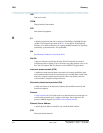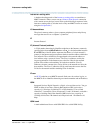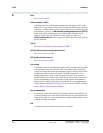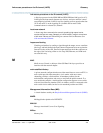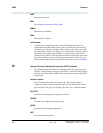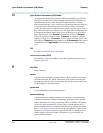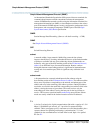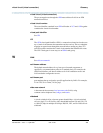
Open System Interconnect (OSI) Model Glossary
Administration for Network Connectivity
CID: 77730 555-233-504 — Issue 1 — April 2000
482
O Open System Interconnect (OSI) Model
An International Standards Organization (ISO) interoperability specification.
OSI defines standard services that compliant communications networks and
equipment must provide, rather than specific implementations. It divides
network operations into 7 steps, called layers, and arranges them hierarchically,
in a protocol stack. The rules (protocols) in each layer of the stack specify a
service that other parts of a communications system can always get, as long as
they make their requests in a standard way. This approach leaves designers free
to implement the internal details of the service in whatever way seems best to
them. The OSI layers are 1 Physical (transmission medium), 2 Datalink
(link-level signaling and error control), 3Network (computer-to-computer
signaling, routing, etc.), 4 Transport (delivery, end-to-end error control, and
flow control), 5 Session (dialog management), 6Presentation (data-format
compatibility), and 7 Application (file-transfer services, virtual terminals,
etc.).
OSI
See Open System Interconnect (OSI) Model.
out-of-service state (OOS)
The condition or state of an MMCX server that is operating but not ready to
accept or place calls.
P PACCON
Packet controller.
packet
A group of bits (including a message element, which is the data, and a control
information element (IE), which is the header) used in packet switching and
transmitted as a discrete unit. In each packet, the message element and control
IE are arranged in a specified format.
packet bus
A wide-bandwidth bus that transmits packets.
packet switching
A data-transmission technique whereby user information is segmented and
routed in discrete data envelopes called packets, each with its own appended
control information, for routing, sequencing, and error checking. The packets
can travel to their destinations by varying routes. For data transmissions, a
packet switched network can make more efficient use of available bandwidth
than a circuit-switched network, because it does not dedicate a channel for the
duration of a call. Instead, packets are queued and sent on a standby basis, as
channel capacity becomes available. The Internet is a good example of a
packet-switching network.



